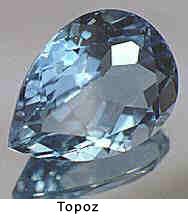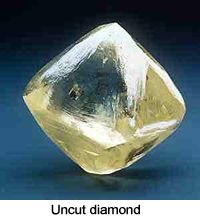BACKGROUND:
 A
mineral is a naturally occurring, inorganic element
or compound with a definite chemical composition, a characteristic
crystalline structure, and distinct chemical properties. The study of
minerals is called mineralogy. It includes mineral identification and
description, the classification of mineral groups, and the study of mineral
occurrences.
A
mineral is a naturally occurring, inorganic element
or compound with a definite chemical composition, a characteristic
crystalline structure, and distinct chemical properties. The study of
minerals is called mineralogy. It includes mineral identification and
description, the classification of mineral groups, and the study of mineral
occurrences.
Gems
are substances that have economic and aesthetic value. Most gems are
minerals. However; some gems are organic substances such as amber, while
others are rocks. Professionals who specialize in the study of gems are
called gemologists.
Crystal form is the natural shape a mineral takes when
it grows into open space. Crystal form reflects the elemental composition
and arrangement of atoms within the mineral. However, most gems are cut or
faceted to make attractive gems.
PROCEDURE:
- Use the Gemstone worksheet to help students visualize gems as a
combination of elements (compounds). The chart is arranged in
"mineral families." Have the students find and list all the
silicate minerals (containing Si and O).
 Instruct the students
to list the other "mineral families" that are
on the Gemstone worksheet. These include corundum, turquoise, diamond, and
spinel. Ask the students what the minerals in each "family"
have in common. Students should recognize that the last part of the
chemical formula (the "suffix") is similar.
Instruct the students
to list the other "mineral families" that are
on the Gemstone worksheet. These include corundum, turquoise, diamond, and
spinel. Ask the students what the minerals in each "family"
have in common. Students should recognize that the last part of the
chemical formula (the "suffix") is similar.
- Ask students to find the most common elements used in the front or
prefix of the chemical formulas. Al (aluminum), Mg (magnesium), Fe
(iron), K (potassium), and Ca (calcium) are most common.
- Students should locate these elements on the periodic table. See
if they can determine if there are any consistent differences between the
positions of the "prefix" and "suffix" of how the
elements are written. They should
see that most of the "suffixes" are in the right side of the
table, and the "prefixes" are mainly on the left. This
reflects how the elements combine to make stable compounds. The minerals
on the left tend to be positively charged, while those on the right
are negatively charged. They combine to make stable compounds.
- Students should look at the different gems in the Gem Kit,
and see how many of them are on the Gemstone worksheet.